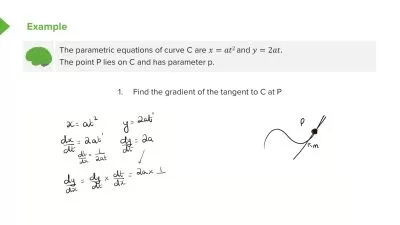Change and Motion: Calculus Made Clear, 2nd Edition
Michael Starbird
12:28:20
Description
One of the greatest achievements of the human mind is calculus. It justly deserves a place in the pantheon of our accomplishments with Shakespeare's plays, Beethoven's symphonies, and Einstein's theory of relativity.
In fact, most of the differences in the way we experience life now and the way we experienced it at the beginning of the 17th century emerged because of technical advances that rely on calculus. Calculus is a beautiful idea exposing the rational workings of the world; it is part of our intellectual heritage.
The True Genius of Calculus Is SimpleCalculus, separately invented by Newton and Leibniz, is one of the most fruitful strategies for analyzing our world ever devised. Calculus has made it possible to build bridges that span miles of river, travel to the moon, and predict patterns of population change.
Yet for all its computational power, calculus is the exploration of just two ideas—the derivative and the integral—both of which arise from a commonsense analysis of motion. All a 1,300-page calculus textbook holds, Professor Michael Starbird asserts, are those two basic ideas and 1,298 pages of examples, variations, and applications.
Many of us exclude ourselves from the profound insights of calculus because we didn't continue in mathematics. This great achievement remains a closed door. But Professor Starbird can open that door and make calculus accessible to all.
Why You Didn't Get It the First TimeProfessor Starbird is committed to correcting the bewildering way that the beauty of calculus was hidden from many of us in school.
He firmly believes that calculus does not require a complicated vocabulary or notation to understand it. Indeed, the purpose of these lectures is to explain clearly the concepts of calculus and to help you see that "calculus is a crowning intellectual achievement of humanity that all intelligent people can appreciate, enjoy, and understand."
He adds: "The deep concepts of calculus can be understood without the technical background traditionally required in calculus courses. Indeed, frequently the technicalities in calculus courses completely submerge the striking, salient insights that compose the true significance of the subject.
"In this course, the concepts and insights at the heart of calculus take center stage. The central ideas are absolutely meaningful and understandable to all intelligent people—regardless of the level or age of their previous mathematical experience. Historical events and everyday action form the foundation for this excursion through calculus."
Two Simple IdeasAfter the introduction, the course begins with a discussion of a car driving down a road. As Professor Starbird discusses speed and position, the two foundational concepts of calculus arise naturally, and their relationship to each other becomes clear and convincing.
Professor Starbird presents and explores the fundamental ideas, then shows how they can be understood and applied in many settings.
Expanding the InsightCalculus originated in our desire to understand motion, which is change in position over time. Professor Starbird then explains how calculus has created powerful insight into everything that changes over time. Thus, the fundamental insight of calculus unites the way we see economics, astronomy, population growth, engineering, and even baseball. Calculus is the mathematical structure that lies at the core of a world of seemingly unrelated issues.
As you follow the intellectual development of calculus, your appreciation of its inner workings will deepen, and your skill in seeing how calculus can solve problems will increase. You will examine the relationships between algebra, geometry, trigonometry, and calculus. You will graduate from considering the linear motion of a car on a straight road to motion on a two-dimensional plane or even the motion of a flying object in three-dimensional space.
Designed for Nonmathematicians
Every step is in English rather than "mathese." Formulas are important, certainly, but the course takes the approach that every equation is in fact also a sentence that can be understood, and solved, in English.
This course is crafted to make the key concepts and triumphs of calculus accessible to nonmathematicians. It requires only a basic acquaintance with beginning high-school level algebra and geometry. This series is not designed as a college calculus course; rather, it will help you see calculus around you in the everyday world.
More details
User Reviews
Rating
Michael Starbird
Instructor's CoursesDr. Michael Starbird is Professor of Mathematics and University Distinguished Teaching Professor at The University of Texas at Austin, where he has been teaching since 1974. He received his B.A. from Pomona College in 1970 and his Ph.D. in Mathematics from the University of Wisconsin-Madison in 1974. Professor Starbird's textbook, The Heart of Mathematics: An Invitation to Effective Thinking, coauthored with Edward B. Burger, won a 2001 Robert W. Hamilton Book Award. Professors Starbird and Burger also collaborated on Coincidences, Chaos, and All That Math Jazz: Making Light of Weighty Ideas, published in 2005. Professor Starbird has won many teaching awards, including the Mathematical Association of America's 2007 Deborah and Franklin Tepper Haimo National Award for Distinguished College or University Teaching of Mathematics, which is the association's most prestigious teaching award. It is awarded nationally to 3 people from its membership of 27,000. Professor Starbird is interested in bringing authentic understanding of significant ideas in mathematics to people who are not necessarily mathematically oriented. He has developed and taught an acclaimed class that presents higher-level mathematics to liberal arts students.

The Great Courses
View courses The Great Courses- language english
- Training sessions 25
- duration 12:28:20
- English subtitles has
- Release Date 2023/05/09










